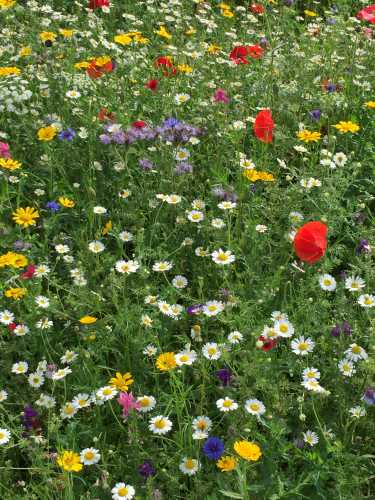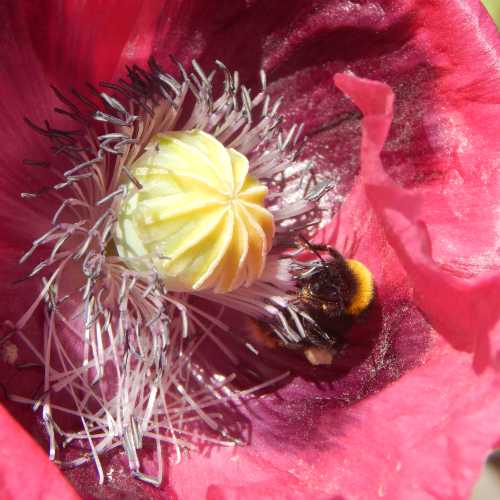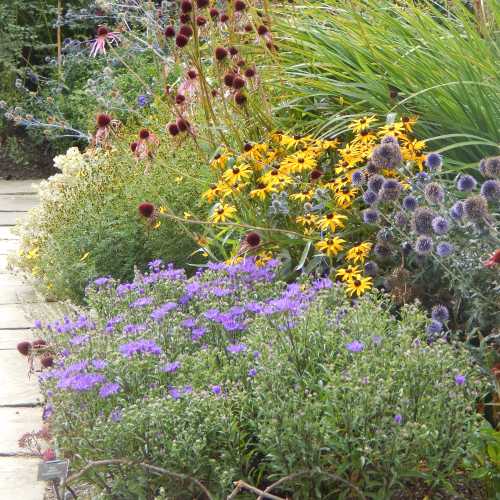Lawns For Bees
Lawns, provided can present excellent opportunities for helping bees.
Depending on your circumstances, opportunities could range from:
- adding bulbs and/or corms
- converting a large grassed area into a wildflower area.
- leaving patches of clover to flourish
- allowing a few wildflowers to thrive in a small area, perhaps added as plug plants
- having a herb lawn, such as thyme.
Do remember, you can also include wildflowers in your flower border. Sometimes, we just need to be a bit flexible in our thinking, rather than stick to the usual ornamentals we've grown accustomed to filling our borders with.
Lawns For Bees Are Great, But It's Important To Be Practical
Before you start, do consider what is practical for your circumstances.
If you have young children who are likely to be running around barefoot or in open-toed sandals whilst bees are foraging, they could get stung if you have a flowering lawn that is attractive to bees.
In such cases, perhaps it is best to leave it until the children are older, or reserve a particular patch for the bees, where the children are taught to observe whilst wearing appropriate footwear.
Not that bees are deliberately out to sting anyone - but accidents can happen if a bee is stepped on!
In addition, if you frequently use chemicals on your lawn, it doesn't make sense to try and make it attractive to bees. They could be poisoned.
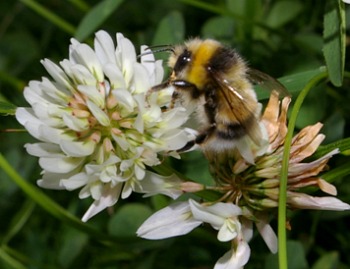 Patches of clover are attractive to bees.
Patches of clover are attractive to bees.
Here are a few ideas to set you on your way to creating a lawn that has some features which are great for bees and other wildlife.
Note:
If you are going to convert a whole area, you'll need to take into account soil conditions, as well as light, and you'll want to ensure you have an appropriate flower mix.
Suppliers can usually offer specific advice depending on your circumstances. The information I'm presenting on this page however, is general, and includes a range of ideas.
Ideas For Pollinator Lawns
1. Include Bulbs and Corms
Many flower bulbs provide excellent
nectar and pollen sources for bees, including during winter and spring.
Consider:
- Snowdrops
Wonderful winter flowering bulb helpful for early emerging bees. Plant in swathes. It's a good idea to buy bulbs 'in the green' to avoid disappointment - Crocuses
Excellent source of pollen in very early spring whilst the weather is cool - Daffodils
Go for traditional varieties, and watch for visiting bumble bees in spring. - Snake's head fritillary
Wonderful flower heads, and visited by bees April/May. - Bluebells - can thrive in dappled shade, and provide fragrant flowers from April or May, perfect in a lawn around a wooded area.
2. Create A Clover Lawn
I have been focusing lately on encouraging clover to spread in my lawn. It offers many advantages:
- bees - especially bumble bee species - love clover!
- it's fragrant,
- it requires little mowing yet looks beautiful - mow 2 or 3 times a year,
- it provides good green cover during drought spells
- eventually when mown, the clippings can be added to your compost heap to help create an excellent natural fertilizer for other plants in your garden. You can also use the clippings as a mulch,
- it can be incorporated into council run pollinator schemes.
3. Mixed Low Growing Flower Patches
You could opt for a selection of low-growing wildflowers that bees like such as: lesser celandines, selfheal, and bird's-foot trefoil, for example. Please check that none of these are considered invasive in your country before encouraging them to flourish in your garden.
However, many gardeners are against these, because of their spreading habit, and some people refer to them as a persistent weed, and you'll need to take these points into account.
If you opt for bird's-foot trefoil, be aware that it can look rather ragged as it dies back for the winter.
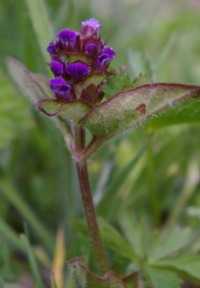 Selfheal is a pretty, low growing flower, but it can spread.
Selfheal is a pretty, low growing flower, but it can spread.4. Create A Herb Lawn
Having a herb lawn, even a small one, is a great way to add interest and variety, as well as helping pollinators. Herbs can provide fragrance and colour, and for bees I certainly recommend a thyme lawn.
According to one study1 thyme may help maintain bee health by providing natural protection against bacteria and diseases.
Read more about this on my page: Do bees like thyme?
5. Create A Wildflower Area
Even small spaces can accommodate many
wildflowers, and this could attract different types of bees and butterflies, by providing much needed pollen and nectar.
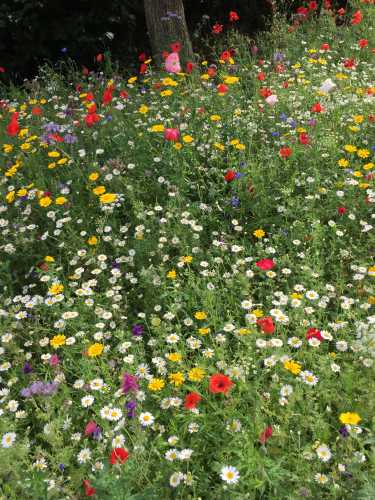
So how can it be achieved? There are several methods:
- The ‘Leave it and See’ Approach
There may be dormant wildflower seeds of native species in the ground from years gone by. To achieve this approach is simple:
- Do not use any fertilizers or treatments on your lawn. Do not add anything that could increase the nutrient value of the soil. Most wildflowers thrive better in nutrient rich soil. Also, do not use any pesticides / insecticides.
- Mow only twice in the year – we mowed early in the spring, then again late autumn. If you wish you can always mow a ‘path’ through the lawn. Mown paths can look quite attractive.
It may take time to see wildflowers, and it really depends on how the land has been used previously.
My personal experience of trying this for several years was unrewarding, but you may have better luck!
- Plug Planting Approach
You could also purchase a few wildflowers as plants, and add them at various places to your lawn. Even better, sow seeds yourself in pots, and ensure you use no chemicals.
This approach will be helpful :
- for plants that may otherwise be difficult to establish,
- to simply reduce the waiting time for your wildflowers to become established,
- to have more control over the wildflowers appearing in your lawn.
- "Roll Out" Wildflower Turf
It's possible to purchase turf which is already established as 'wildflower turf'. I have no experience of this but the idea seems interesting. - Create a Wildflower Area from Scratch
For this approach, remove the top layer of turf. Sow a wildflower seed mix in Spring or Autumn, and cover with a fine tilth. Hopefully, your seed mix will contain annuals that will soon give you glorious colour. In a year or two, the perennial flowers should show up.
Get advice from a supplier about the best selection of wildflowers for your growing conditions. A wildflower mix could include any of these, among others:
Field Scabious
Teasel
Ox Eye Daisy
Yellow Rattle
Meadow Cranesbill
Cowslip
Selfheal
Greater & Lesser Knapweed
Red Campion
Betony
Meadow Buttercup
Musk Mallow
Poppy
Vetches
References and resources
1. Wiese, N., Fischer, J., Heidler, J. et al. The terpenes of leaves, pollen, and nectar of thyme (Thymus vulgaris) inhibit growth of bee disease-associated microbes. Sci Rep 8, 14634 (2018). https://doi.org/10.1038/s41598-018-32849-6
See internal links to other resources on this site.
FREE PDF DOWNLOAD:
Planning And Planting A Bee Friendly Garden
If you found this page helpful or interesting, I'd really be grateful if you would share it with others - if not this page, perhaps another, such as Gardening For Bees.
Thank you so much :) .
